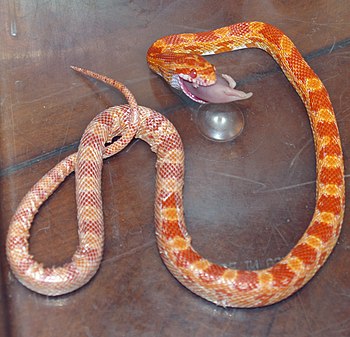The bucktooth tetra (Exodon paradoxus) is an interesting and unique addition to the home aquarium, but it brings along various challenges that must be met for its successful keeping. Most of these difficulties revolve around its nasty behavior in captivity. In fact, some aquarists may argue that, ounce for ounce, E. paradoxus is one of the most aggressive fish available in the hobby.
 |
| Bucktooth Tetra (Exodon paradoxus) (Photo credit: Wikipedia) |
Characteristics
The bucktooth tetra is native to the Amazon River Basin and Guyana areas. When one hears the name, it brings about images of large, protruding teeth, but in reality, the appearance of E. paradoxus is not that extreme. A casual examination of the mouth reveals that E. paradoxus has serrated lips but not the pronounced dentition that one might associate with a name like bucktooth tetra.
Though this may initially seem disappointing to hobbyists looking for a fish with large, visible teeth, E. paradoxus has tremendously powerful jaws for its size, and its teeth are more pronounced and well developed in comparison to that of various community tetras.
The color scheme of E. paradoxus is beautiful: a bright, metallic-silver base accompanied by yellow fins with orange and red tips. Throughout the body are casts of yellow, red, and green. There are also two large black spots, one near the middle of the body and the other at the base of the tail. When maintained under optimum water quality and good lighting, the metallic sheen of the body often reflects blue and purple iridescence.
In the wild, E. paradoxus is a shoaling species with carnivorous tendencies. Insects, small fish, shrimp, and other forms of meaty fare make up the bulk of its diet, but the bucktooth tetra is also a well-known lepidophage (scale eater). This specialized form of feeding creates a problem for aquarists, making almost any fish kept with E. paradoxus at risk for injury.
Keeping the Bucktooth Tetra
E. paradoxus offered for sale at most aquatics stores usually measure 2 to 3 inches long, but they are capable of growing to around 6 inches. It is a slow-growing species, but for every inch that the fish puts on in length, a substantial amount of bulk and body mass is acquired. The bucktooth tetra spends most of its time midwater, but all levels of the aquarium are explored when food is added to the tank or the activity of another inhabitant catches its attention.
Being an extremely active fish, adult specimens must be kept in aquariums that are both long and wide. The minimum size would be a standard 55-gallon aquarium, but, as always, the bigger the better. E. paradoxus is highly adaptable to a wide range of water parameters, but extremes should be avoided. An ideal pH range would be roughly 6.2 to 7.4. Large, frequent water changes are enjoyed, and the bucktooth tetra often becomes even more active after routine maintenance.
The bucktooth tetra is not a picky eater in captivity and will accept various foods, such as brine shrimp, mysid shrimp, bloodworms, chopped earthworms, beef heart, cut fish fillet, as well as flake and pellet foods to balance out nutrition. I have a few spare tanks in which I breed feeder guppies and gutload them with veggie flakes before offering them to my various smaller predatory species.
My E. paradoxus are remarkably precise and efficient predators, often snatching guppies at the water surface extremely quickly. The only way I can tell that they are actually catching the guppies is from the small lumps in their stomachs. When any type of food hits the water, it sparks a feeding frenzy unparalleled by most other aquarium species.
Tank decor can include pieces of driftwood, rocks, slate, pots, and artificial caves. Driftwood with a root-system-like appearance makes for striking scenery, as a school of E. paradoxus will endlessly zip in and out of the root-like structures throughout the day. Although bucktooth tetras spend most of their time out in the open, hiding places are utilized to take an occasional break from their seemingly endless activity.
E. paradoxus show their colors best when maintained with a dark substrate and live plants accompanied by a dark background. Suitable plants include broad-leaved species such as Amazon swords and Java fern, as well as various grass-like plants such as Vallisneria species.
Floating plants are also appreciated by E. paradoxus for providing shaded areas and creating a more realistic environment. To find out more, you can check out Buck Tooth Tetra.
Hi, I'm a traveler, fishes fanatic, reader and teacher. I hope to share my fishes experiences with you through my articles. If you like my articles, do share with your friends. I thank you for that first. Article Source: EzineArticles |







